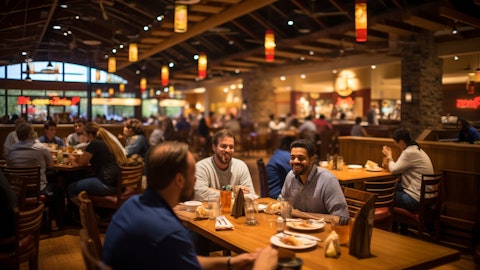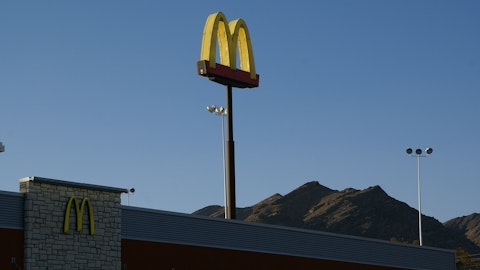Lauren Silverman: Thank you.
Operator: Thank you. Our next question coming from the line of Brian Bittner from Oppenheimer. Your line is open.
Brian Bittner: Thanks, good morning. You announced today that you will be closing 50 of the U.K. company-operated units. But at the same time, you gave some positive commentary on trends in the U.K. sequentially improving trends, comps are positive. So arguably a better U.K. outlook. So are these restaurants you’re closing? Are they just, in your mind, kind of a lost cause? Or can you help us understand the decision to close these stores rather than continue to try and get the benefits that comes from turning them around?
Rob Lynch: Yes, for sure. Thank you for the question, Brian. The U.K. has been something that has been a bit of a labor of love over the last 18 months. We believe in the long-term viability of that market, we have great franchisees who are running great operations. But we also have — we’ve also had some stores that have not been operated as well. And so that’s both in the company portfolio that we took over as well as in the franchisee base at large. So as we stated earlier, we have been working over the last year to get a lot of the restaurants that we see having long-term potential, but maybe not operated in the most effective way, transition from their former franchisees to new franchisees that are — or current franchisees in the system that run better operations.
And we’ve seen a lot of benefit in those restaurants and improvement, both on the top and bottom line from those transitions. The 50 restaurants that we’re talking about closing are company stores that we believe will not benefit simply from better operations. They have locations where the trade zones have moved or other challenges that, frankly, will not be easily mitigated to get them to profitability. So we will still own about 68 restaurants in that market. Our objective is to continue to optimize that portfolio, which may include refranchising some of those restaurants to great franchisees. But the ones that we’re closing, yes, exactly what you said. Those are restaurants that aren’t going to be able to get to profitability anytime soon.
And hence, our decision to close those.
Brian Bittner: Okay. Thank you.
Rob Lynch: Thanks, Brian.
Operator: Thank you. And our next question coming from the line of Eric Gonzalez with KeyBanc. Your line is open.
Eric Gonzalez: Thanks. Good morning. I have a 2-part question, if I may. And it’s on the back of better 2.0 initiative. You’ve made it clear that national advertising is significantly more efficient than regional or local. But I think there is some skein out there about the impact of going from 8% to 6%. So is there anything you can tell us to reassure investors that the incremental point of national can more than offset those 2 points that you’re giving up on the local side? That’s the first part. And the second part is in your conversations with your franchisees, do you get the sense that they’re going to abandon the local market entirely? Or do you think that the majority will keep spending at or near the prior year levels.
I would think that in year one of the program where the commissary commission is just starting to be phased in at the higher rates, but the majority of operators will continue to spend in the local markets. Is there any way that you can maybe quantify the net effect of all this?
Rob Lynch: Yes. Great question. What I would say is that there’s a lot more consistency on the returns on advertising spend at the national level than there are at the local level. Some franchisees were able to invest their local dollars in productive ways. A lot of franchisees were not using those dollars as productively and not necessarily because they chose not to. It’s just because the funds were not at a scale where they could buy media in their markets that was as productive and efficient as we can buy at the national level. So when we look at the return on advertising spend, we’re seeing over a 25% improvement at the national level versus the local level. So if you think about it, net-net, if we were comparing apples-to-apples, we’re reducing the total advertising investment by about 25%, and you’re getting a 25% pickup on that.
So that’s why we think it’s at least comparable. But then when you layer in the tools that we have just developed with our — we brought on a new media partner who is working with us to develop better analytical tools that allow us to target more efficiently will allow us to deploy media more efficiently. All of that at the national level will become more effective than those ROIs that we have evaluated in the past. So we have a lot of confidence that despite going from 8 to 6, we’re going to see significant improvement and impact of that 6%. On your second question, or I’ll say, the second part of the first question because we’re only allowing one question you know — the — we do believe that some franchisees will continue to spend above that 6% level, especially in the first 2 years, primarily because they have entered into agreements with local sports teams in their markets that they are contractually obligated to continue with.
But I see some of our franchisees and frankly, some of our company markets that we own, we will continue to spend at higher than 6% levels because of those partnerships. I’ll give you an example here in Atlanta, we are partners with the Braves and the Hawks, and we activate with them, and we see great returns when we do that. So we will continue to invest in those partnerships. And I think our franchisees who leverage those types of partnerships and their markets will continue to invest as well.
Eric Gonzalez: Thank you.
Operator: Thank you. And our next question coming from the line of Brian Mullan with Piper Sandler. Your line is open.
Brian Mullan: Thank you. Just a follow-up on the U.K. business. As you go through this strategic restructuring process, which, Rob, I think you said you might refranchise the remaining 6 company-owned stores. But I’m just wondering what happens to the commissary business over there. Is that something you want to continue to own longer term? Is it important strategically for you to own it? Just any thoughts on that part of the business.




